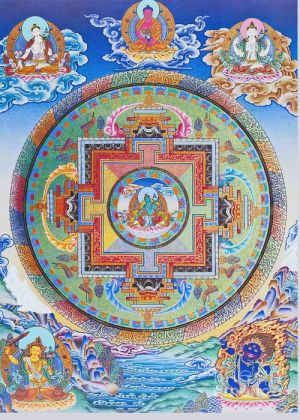Eight conscious The eight consciousnesses (Skt. aṣṭavijñāna; Tib. རྣམ་ཤེས་ཚོགས་བརྒྱད་, namshé tsok gyé, Wyl. rnam shes tshogs brgyad), or eight collections of consciousnessnesses
The eight consciousnesses (Skt. aṣṭavijñāna; Tib. རྣམ་ཤེས་ཚོགས་བརྒྱད་, namshé tsok gyé, Wyl. rnam shes tshogs brgyad), or eight collections of consciousness, are a model of vijnana (consciousness) posited by the Yogacara school of thought. This model consists of:
the defiled consciousness, klistamanas
the storehouse consciousness, ālayavijñāna
Aspects of vijnana (modes of consciousness)
All schools of Buddhist thought accept a model of vijnana consisting of six modes or aspects. The Yogacara school of thought, which is very influential in East Asia and Tibet, also posits a model of eight modes of consciousness.
Six vijñānas Main article: Six consciousnesses The six consciousness model for vijnana identifies the following six consciousnesses:
Visual (or eye) consciousness (Skt. cakṣur-vijñana; Tib. མིག་གི་རྣམ་ཤེས་, Wyl. mig gi rnam shes) Auditory (or ear) consciousness (Skt. śrotra-vijñana; Tib. རྣ་བའི་རྣམ་ཤེས་,Wyl. rna ba'i rnam shes) Olfactory (or nose) consciousness (Skt. ghrāṇa-vijñana; Tib. སྣའི་རྣམ་ཤེས་, Wyl. sna'i rnam shes) Gustatory (or tongue) consciousness (Skt. jihva-vijñana; Tib. ལྕེའི་རྣམ་ཤེས་, Wyl. lce'i rnam shes) Tactile (or body) consciousness (Skt. kāya-vijñana; Tib. ལུས་ཀྱི་རྣམ་ཤེས་, Wyl. lus kyi rnam shes) Mental (or mind) consciousness (Skt. mano-vijñana; Tib. ཡིད་ཀྱི་རྣམ་ཤེས་, Wyl. yid kyi rnam shes)
Alexander Berzin states:
Unlike the Western view of consciousness as a general faculty that can be aware of all sensory and mental objects, Buddhism differentiates six types of consciousness, each of which is specific to one sensory field or to the mental field. A primary consciousness cognizes merely the essential nature (ngo-bo) of an object, which means the category of phenomenon to which something belongs.[1] In this model, for example, when an eye consciousness makes contact with an object such as a cup or a vase, there is a moment of just seeing the raw data without any discrimination about what is being seen. In the next moment, the raw data is transmitted to the mental consciousness, which interprets the data and forms the thought of a "cup" or a "vase".
Eight vijñānas The Yogacara school identifies two additional types of vijnana:
the defiled consciousness, klistamanas the storehouse consciousneess, ālayavijñāna Rupert Gethin explains:
Early Buddhist thought analysed consciousness as consisting of six basic types corresponding to the five senses and the mind. Building on the traditions of the earlier Ābhidharmikas, Yogācārin thinkers give what amounts to a rather more complex account of the sixth, mind consciousness, focusing on what are in effect the deeper layers of the mind. The active or surface level of the mind continues to be seen as comprising six type of consciousness: our primary awareness of five types of sense data and our conscious thoughts, which for human beings are mostly related to the former in various ways. But underpinning these types of active consciousness are two further types of consciousness which are crucial in creating the world as we ordinarily experience it. The first is ‘the defiled mind’ (kliṣṭa-manas), so called because it is afflicted with four basic defilements: the view of individuality, the conceit ‘I am’, clinging to self and delusion. The object of this defilement, what the defiled mind in some way takes as the self, is the eighth consciousness, ‘the store consciousness’ (ālaya-vijñāna).41 Below the threshold of consciousness proper, the store consciousness is the particular repository of all the seeds sown by the defilements of a being’s active consciousness; it is the result of a being’s past karma, the accumulation of all past tendencies, strong or weak, to greed, hatred, and delusion; as such the store consciousness is also the condition for the perpetuation of these defilements in present and future active consciousness; it thus continually interacts with active consciousness according to the principles of dependent arising.[2] Alexander Berzin states:
The [[[Yogacara]]] schools add two more types of primary consciousness to make their list of an eightfold network of primary consciousnesses (rnam-shes tshogs-brgyad): deluded awareness (nyon-yid), alayavijnana (kun-gzhi rnam-shes, all-encompassing foundation consciousness, storehouse consciousness). Alayavijnana is an individual consciousness, not a universal one, underlying all moments of cognition. It cognizes the same objects as the cognitions it underlies, but is a nondetermining cognition of what appears to it (snang-la ma-nges-pa, inattentive cognition) and lacks clarity of its objects. It carries karmic legacies (sa-bon) and the mental impressions of memories, in the sense that both are nonstatic abstractions imputed on the alayavijnana. The continuity of an individual alayavijnana ceases with the attainment of enlightenment.[1] According to Walpola Rahula, the "store consciousness" of Yogacara thought exists in the early texts as well, as the "citta."[3]
Origin and development
According to Gareth Sparham,
The ālaya-vijñāna doctrine arose on the Indian subcontinent about one thousand years before Tsong kha pa. It gained its place in a distinctly Yogācāra system over a period of some three hundred years stretching from 100 to 400 C.E., culminating in the Mahāyānasaṁgraha, a short text by Asaṅga (circa 350), setting out a systematic presentation of the ālaya-vijñāna doctrine developed over the previous centuries. It is the doctrine found in this text in particular that Tsong kha pa, in his Ocean of Eloquence, treats as having been revealed in toto by the Buddha and transmitted to suffering humanity through the Yogācāra founding saints (Tib. shing rta srol byed): Maitreya[-nātha], Asaṅga, and Vasubandhu.
Source
